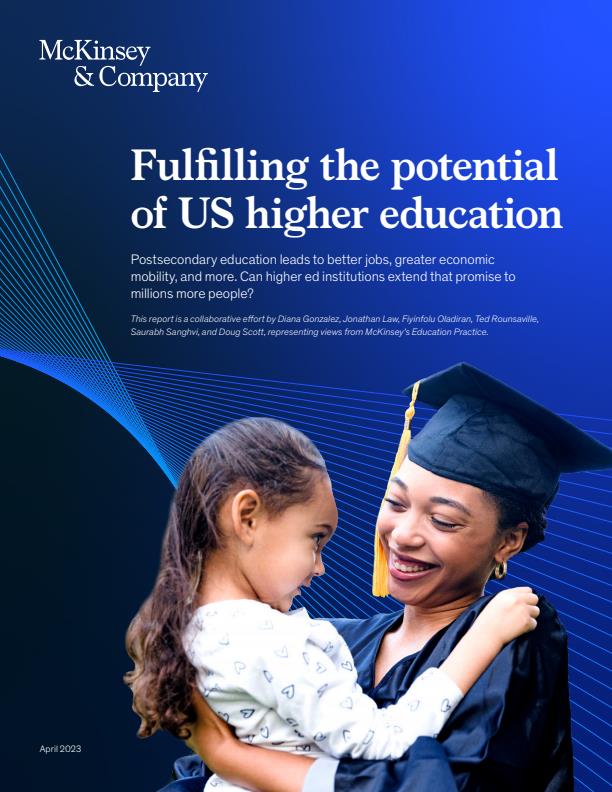The US higher education system faces crises on multiple fronts. Enrollment growth is slowing, student debt is at an all-time high, the sector is not delivering on its promise of greater equity, and its reputation among many Americans is declining.1 We believe there is a challenging but clear solution. Higher ed must remain focused on its core mission of educating learners but evolve its practices to serve more Americans. Our analysis suggests that the sector should aspire to a bold goal: graduate ten million more students than currently projected over the next 20 years. This goal is ambitious, but the data show there is a pathway to achieving it in a way that successfully addresses the sector’s challenges rather than exacerbating them.
Bachelor’s degrees, associate’s degrees, and Title IV–eligible certificates remain among the most proven enablers of economic mobility and individual empowerment in the United States.2 Controlling for sociodemographic variables, graduates with bachelor’s degrees earn a median of $450,000 (for women) to $655,000 (for men) more over their lifetimes than those who have only a high school diploma, and studies show that this earnings premium is increasing.3 Furthermore, a postsecondary degree has significant nonmonetary benefits, from better health outcomes to greater civic engagement.4 For society, these benefits have compounding effects on the economy through GDP gains, increased tax payments, and reduced reliance on social services.5
The benefits of a postsecondary degree are clear, but they are not distributed equally throughout society. Black and Hispanic Americans have the lowest rates of educational attainment, with only 21 percent of Hispanics and 28 percent of Black Americans having a bachelor’s degree or higher, compared with 42 percent of non-Hispanic Whites and 61 percent of Asian Americans.6 Benefits are also distributed unequally across institutions; many schools, particularly those that serve a significant share of underrepresented and low-income students, fail to graduate large percentages of their student body every year, leaving millions in debt with no diploma to show for it.7
In another troubling trend, enrollment rates have declined across the board in recent years, largely due to three factors: a drop in the US birth rate since the Great Recession, changing perceptions about the costs and benefits of earning a degree, and fallout from the COVID-19 pandemic.8 Even as enrollment has fallen, however, demand for workers with degrees has risen. Our analysis indicates that 86 percent of new jobs projected to be created through 2030—in fields such as nursing, teaching, and cybersecurity—will likely require postsecondary education.9 This talent shortage represents a significant risk to the nation’s public health, education, security, and global competitiveness.
Finally, as student loan debt has increased, so too has skepticism about the value of postsecondary education—a shift that has been exacerbated by the pandemic. In May 2021, 65 percent of college students surveyed agreed with the statement that higher education is no longer worth the cost, up from 57 percent in December 2020 and 49 percent in August 2020.10
These statistics raise a pressing question: how can the sector improve its value proposition and extend the benefits of higher education to more Americans while creating more-equitable economic mobility and a stronger economy? Two steps are necessary.
First, while there is capacity in the system, higher ed institutions must demonstrate that they can successfully graduate their students before expanding enrollment. It is especially important that schools demonstrate the ability to graduate the most vulnerable students. An analysis of enrollment and completion reveals that only 11 percent of the available capacity in the higher education sector is at schools that have both above-average completion rates and an above-average share of students eligible for federal Pell Grants for low-income students.
The sectorwide average completion rates for bachelor’s and associate’s degrees—64 and 34 percent, respectively—make it difficult to justify expanding enrollment further.11 However, an institution-by-institution view reveals a more nuanced story and demonstrates that there is real potential for significant systemwide improvement (exhibit).

First, completion rates vary widely by institution for both bachelor’s and associate’s degrees. Second, there are big differences between high- and low-performing schools when controlling for the type of institution and the share of Pell Grant–eligible students. Even when adjusting for institution peer group by Carnegie Classification—a framework for describing institutional diversity in US higher ed—the average gap in completion rates between high- and low-performing two- and four-year institutions remains 30 percentage points.12 This suggests that completion rates aren’t fated based on a school’s programs or student profile. The actions a school takes—how it engages and supports its students—can have a big influence on how many students graduate. Third, a number of schools have shown that large improvements over a ten-year period are possible: 141 bachelor’s-granting schools with at least 4,000 students have improved completion rates by at least ten percentage points in the past decade.13
Expanding enrollment could become the next priority—particularly for lower-income students, since only 11 percent of available two- and four-year capacity is at institutions with above-average completion rates and Pell Grant–eligible student shares. Increasing enrollment by 2 to 3 percent a year while implementing measures to improve completion rates could create enough additional capacity to realize the “ten in 20” goal.
The total cost of producing ten million additional graduates over 20 years would be roughly $1.2 trillion across all stakeholders. These costs could be reduced if higher education institutions increased affordability and decreased barriers to education, for example through online and hybrid programs and tuition installment plans. They can also be mitigated through academic offerings that lead to higher completion rates and higher-paying jobs. Higher education funders will need to collaborate to help finance this effort and ensure that potential students both graduate and find gainful employment.
A McKinsey analysis of more than 100 interventions aimed at improving access and completion points to four broad barriers facing learners and the general measures needed to remedy them:
- Affordability and financial resources. Make college more affordable, from strategically timed financial aid to low-cost “wraparound” services like childcare that make pursuing a degree possible.
- Access to information. Provide better access to information about how to enroll, how to get financial aid, and what the possible outcomes of various programs can be.
- Mindset and preparedness. Help students feel they’re up to the task through pre-enrollment programs and extracurricular experiences.
- Support services and networks. Ensure that students have the support they need, from mentors to career and professional guidance.
Higher education funders and institutions could take the following five decisive actions to address these barriers and achieve the ten in 20 goal:
- Prioritize the 52.5 million potential adult learners without college degrees through creative support structures, more-flexible class schedules, and tailored instructional modalities.
- Fill excess capacity in US universities, starting with the 1.65 million open seats in top-performing institutions with high completion rates.
- Deploy student-specific, data-driven interventions to improve access and close the 45-percentage-point gap in completion rates, supporting students from enrollment to employment.
- Guide students toward high-ROI, high-employment pathways through enrollment in the 64 percent of postsecondary programs that offer positive ROI within ten years.
- Explore options to improve college affordability through cost efficiency and new financing mechanisms.
Graduating ten million more graduates in 20 years is in many ways an imperative for the future success and resilience of the country. The United States needs more graduates to fill skilled jobs; drive greater economic growth, mobility, and competitiveness; increase civic engagement; and improve health outcomes and national security. And hanging in the balance are individuals—ten million of them—on whom the future of the nation, and its promise, may well rest.



